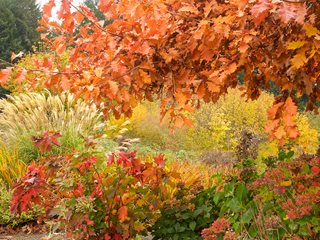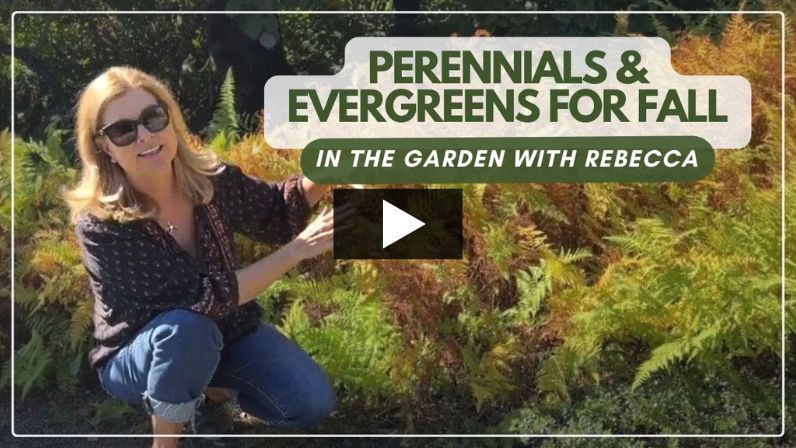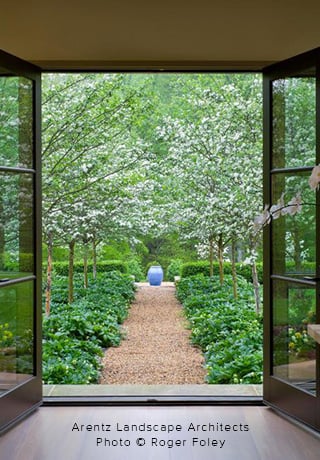Fall Landscaping Ideas: Celebrate the Season’s Color & Light
Celebrate the end of the growing season with gorgeous autumn colorFall is an often-overlooked season in the garden, with many gardeners focused on spring and summer color. Yet there are many plants with late-season interest that thrive in the shorter, cooler days of fall, offering a glorious curtain call before the landscape goes dormant for the winter.
When designing a fall border, think about layers of texture, structure and color from a variety of trees, shrubs, perennials and annuals. Choose varieties with late season ornamental attributes including flowers, fruit, seed heads and colorful foliage. Include plants such as conifers and broadleaf evergreens that look good year-round. Even the decaying leaves of plants such as hostas, ferns and peonies have a fleeting beauty of their own.
To celebrate the season’s rich bounty, adorn the yard, porches, patios and containers with pumpkins, gourds and cornstalks for a decorative touch. Follow these fall landscape ideas for designing a gorgeous late-season landscape that puts an exclamation point at the end of the growing season.
On this page:- HOW TO MAKE A FALL GARDEN
- FALL GARDEN PLANTS
- FALL LANDSCAPING IDEAS
- HOW TO MAINTAIN A FALL GARDEN
- FAQs
- FALL GARDEN DESIGN INSPIRATION
HOW TO MAKE A FALL GARDEN
Choose and evaluate your site.
Pick a site in full sun to partial shade with well-draining soil. Improve the soil in garden beds as needed. An area that receives direct sunlight early or late in the day will produce backlighting to highlight ornamental grasses, Japanese maples and other plants for a dramatic effect.
Research.
Peruse books and online sources for garden idea pictures and inspiration, and visit local gardens and parks with fall color. Make a list of your favorite fall plants.

A cozy fire pit area provides a warm place to sit on cool fall evenings. Designer: Vanessa Gardner Nagel. Photo: Janet Loughrey.
Draw a design.
When creating a fall garden design, draw a rough sketch using the fall plants you want to include. This might involve designing an entire new garden bed, or adding fall plants to an existing border.
Consider scale.
Choose plants that won’t outgrow their space. For a small urban garden, include dwarf varieties. A spacious property can accommodate larger plants with fall interest such as ginkgo tree and sugar maple.
Personal style.
Choose fall plants and accessories that complement the style of your home and reflect your own personal tastes.
FALL GARDEN PLANTS
Choose plants with seasonal attributes such as flowers, fruit, seed heads and colorful fall foliage. Some of the best garden plants for fall interest include:
- Fall Trees: Beech, crabapple, crape myrtle, dogwood, ginkgo, Japanese maple, oak, redbud, stewartia, sugar maple, sumac.
- Shrubs: Barberry, beautyberry, burning bush, chokeberry, cotoneaster, elderberry, fothergilla, heather, heavenly bamboo, holly, hydrangea, mahonia, ninebark, smokebush, sweetspire, viburnum, witch hazel.
- Fall Perennials: Aster, black-eyed Susans, blue star, chrysanthemum, coneflower, goldenrod, helenium, ironweed, Japanese anemone, Joe pye weed, ornamental grasses, salvia, sedum, toad lily.
- Vines: American bittersweet, Boston ivy, clematis, firecracker vine, hops, grape, Virginia creeper.
- Annuals: Amaranth, castor bean, coleus, cosmos, ornamental kale, ornamental millet, pansy, ornamental pepper, purple fountain grass, snapdragon, sunflower, zinnia.
- Bulbs: Abyssinian gladiolus, amaryllis, autumn crocus, crinum lily, cyclamen, dahlia, lycoris, nerine.
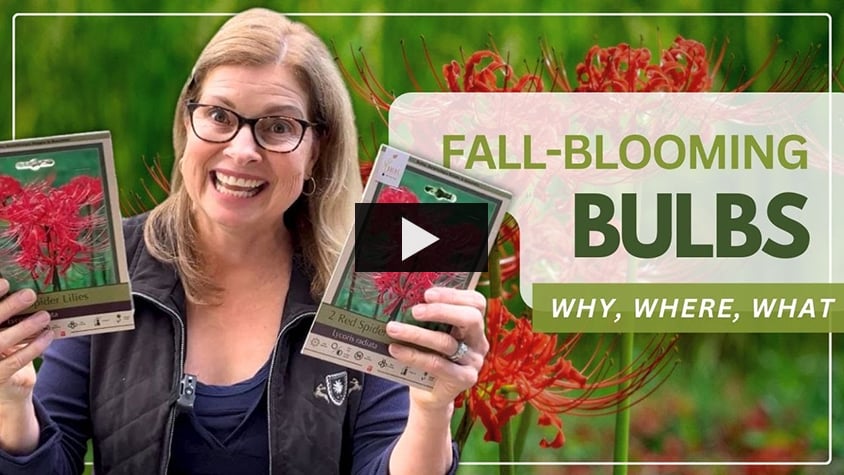
Rebecca Sweet talks about adding fall blooming bulbs to her late-season garden. See more of her favorite plants for the fall garden.
FALL LANDSCAPING IDEAS
Use these fall garden ideas when designing your yard for autumnal color:
Extend the season.
Use a mix of perennials, shrubs and trees that have fall color at different times to extend the autumn season from the end of summer to early winter. Dried flower heads and seed heads provide structural interest into winter. Though fall color can be fleeting, including a diverse variety of plants creates an ever-changing look.
Rebecca Sweet suggests ways to extend the fall season by creating harmonic plant combinations.
Create layers.
Include plants in different sizes and shapes to create a layered tapestry. Choose varieties with different late-season attributes such as fall flowers, berries and seed heads, along with contrasting colors for dramatic vignettes.
Karen Chapman of Le Jardinet Designs shares her design-inspired fall vignettes.

A stunning golden yellow Japanese maple is a statement tree in this fall border. Grasses, shrubs and perennials complete this captivating vignette. Designer: Laura Crockett. Photo: Janet Loughrey.
Structure.
Combine plants with different shapes and heights for multi-seasonal structure. A vase-shaped ‘Sango Kaku’ Japanese maple tree would pair well with mounding Virginia sweetspire shrub and spiky ‘Prairie Winds’ little bluestem grass.
Plant in drifts.
Plant ornamental grasses and other perennials such as blue star and asters in drifts for greater visual impact.
Texture.
Consider texture when choosing plants, and combine different textures for contrast. Plant feathery ornamental grasses with bold-leafed sedum. The finely textured foliage of Arkansas blue star (Amsonia hubrictii), which turns brilliant golden yellow in fall, pairs well with the oval red leaves of burning bush (Euonymus alatus).
Light.
Utilize the low angle of the sun to showcase the color, texture and form of plants such as ornamental grasses, Japanese maples, and burning bush. Backlighting illuminates the colors for a fiery display. Position plants so they catch the first rays of light in the morning or the last rays of light in late afternoon.
Rebecca Sweet shares how fall’s fantastic light transforms her garden with autumn’s glow.
Foliage color.
Combine plants in complementary colors. Silvery plants such as lamb’s ear and artemisia, or blue plants such as ‘Blue Star’ juniper and Colorado blue spruce can be paired with fall plants in warmer hues of red, yellow and orange for a pop of dramatic contrast.
Plant for year-round color.
Include conifers and broadleaf evergreens for year-round color and structure. Some evergreen or semi-evergreen plants acquire different hues during the colder weather of fall and winter, such as heavenly bamboo, pigsqueak, and coral bells.
Vertical interest.
Vines, trellises and arbors provide vertical interest along borders, patios and buildings. Include vines with fall color such as Boston ivy and Virginia creeper.

This welcoming front porch is adorned with fall-themed potted plants and decorative accessories. Designers: Rob Saba and Mark Hogan. Photo: Janet Loughrey.
Adorn an entryway.
Create a welcoming entrance to your home by placing potted plants, pumpkins and gourds on the front porch and steps. Place large decorative containers on either side of the front door and plant with evergreens such as boxwood or holly. Adorn with twinkling lights for a seasonal display through winter. Get more fall front porch ideas.
Dried arrangements.
Use cut plant materials at your fingertips to create fall arrangements. Include hydrangea flower heads, colorful leaves, grass plumes, seed heads, and berries. Display arrangements on an indoor tabletop or in outdoor living areas.
Patios, decks, balconies.
When decorating outdoors for fall, adorn outdoor seating areas including patios, decks and apartment balconies. Create artful vignettes using potted mums, miniature pumpkins, string lights or candles to make outdoor living spaces more inviting. Add harvest-colored pillows and blankets to outdoor loungers and chairs for cozy warmth on cool fall evenings.
Containers.
Display decorative planters in rich fall colors of red, orange, yellow, bronze and brown and plant with your favorite fall varieties such as asters, mums, grasses, ornamental kale and peppers. Group fall containers together for greater visual impact.
Karen Chapman of Le Jardinet Designs shares tips for easy fall containers.
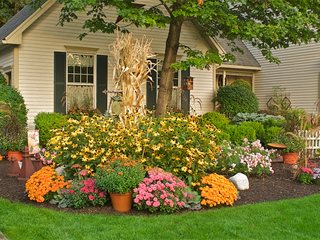
Potted mums and dried cornstalks are interspersed in this front yard border for a fall touch. Designers: Rob Saba and Mark Hogan. Photo: Janet Loughrey.
Decorate the yard.
Display fall garden decor in the front yard and backyard that celebrates the season, such as wreaths, pumpkins, gourds, bundled corn stalks, and hay bales. Intersperse your favorite fall plants and add string lights for a festive touch.
Plant for wildlife.
Include plants that provide food for wildlife from fall into winter. Perennials such as black-eyed Susan and purple coneflower produce seeds that feed chickadees, sparrows and goldfinches. Annual amaranth feeds a wide array of songbirds such as finches, sparrows, juncos and chickadees. Winterberry, crabapple, viburnum, chokeberry, and dogwood produce attractive fall berries that feed a wide range of wildlife including squirrels, raccoons, deer and songbirds.
Vegetable gardening.
While warm season vegetable plants such as tomatoes, peppers and cucumbers are winding down for the season, other vegetables prefer the cooler air temperatures of autumn. Mid summer to early fall is a good time to plant fall vegetable crops such as greens, carrots, onions, kale, broccoli and cabbage for a fall or spring harvest.
Fall planting.
Fall is a great time to renovate existing borders or install new plants. Cool weather is good for planting, and the soil is still warm. Local nurseries and garden centers often have end-of-the-season sales on trees, shrubs and perennials. Plant or transplant 4 to 6 weeks before the average first frost date in your region to allow roots to become established. Mulch plants before the ground freezes for extra winter protection. Learn more about planting in the fall.
HOW TO MAINTAIN A FALL GARDEN
Fall gardens are ever-evolving as leaf color changes and plants lose their foliage. To keep fall gardens looking their best, stay on top of maintenance chores.
- Clean up leaves: Fallen leaves can have a beauty of their own. Allow freshly fallen leaves to remain on the ground, or rake them up if preferred. Spent leaves can be used as mulch, or added to the compost pile.
- Weed: Fall is a good time to keep weeds under control. Weed germination declines considerably in fall, though some weeds will continue to self-sow. Weeding in fall can help reduce the amount of weeds in spring.
- Prune: Remove any dead, diseased or broken branches from trees and shrubs as needed. Cut herbaceous perennials back to the ground, or leave them for winter interest. Leaving perennials alone until spring provides habitat for wildlife and overwintering insects.
Check out our full guide to fall garden cleanup.
FAQs
How can I design a fall garden with seasonal color?
Include plants with late-season interest such as flowers, berries, seed heads and foliage color. Accentuate with decorative accessories such as containers, seasonal pumpkins and gourds.
How do I extend my garden’s color into late fall?
Plants such as chokeberry, hydrangea, ninebark and viburnum have multiple fall attributes such as berries, dried flowers and colorful fall foliage that last through fall and winter. Evergreen trees and shrubs provide year-round color and structure.
How can I combine mums, asters, and ornamental grasses?
Plant these quintessential fall varieties together in a container, bed or border and use complementary colors. Taller grasses provide background interest, texture and movement, while flowers add brilliant color.
How do I decorate my garden for fall?
Use seasonal accessories such as wreaths, dried flowers, pumpkins, scarecrows and hay bales to get the look of autumn.
How do I create a low-maintenance fall garden?
Include plants that require little or no supplemental watering and fertilizing. These include most trees and shrubs, and perennials such as ornamental grasses.
What are good container garden ideas for fall?
Mums come in a wide range of sizes and flower colors, making them one of the most versatile plants for fall containers. Include a thriller such as tall ornamental grass, a filler such as a bushy mum or aster, and a spiller plant such as creeping Jenny. Group containers together for more visual impact, or use a single specimen in a container as a stunning focal point.
What colors and textures work best for a fall landscape design?
To evoke the season, use warm colors such as red, orange, yellow and beige. Combine different textures for contrast, such as finely textured ornamental grasses with the bolder leaf shapes of Japanese maple or viburnum.
Related reading: 10 Elements & Principles of Landscape Design
What trees and shrubs provide the best fall foliage?
There are many trees and shrubs that produce stunning fall foliage. These include Japanese maple, sugar maple, ginkgo, burning bush, smoke bush and sumac.
How can I add lighting to highlight fall colors?
Use spotlights or uplights to highlight statement trees or shrubs. Warm yellow or amber lights accentuate the vibrance of fall foliage. String lights add a more subtle touch. Check out more options for lighting up your landscape.
FALL GARDEN DESIGN INSPIRATION

Different colors, forms and textures combine for a captivating fall border. Designer: Laura Crockett. Photo: Janet Loughrey.

Evergreen and deciduous trees, shrubs, perennials and ground covers are planted in a layered tapestry in this spectacular fall border. Designer: Laura Crockett. Photo: Janet Loughrey.

This small urban yard is packed with fall color, with added color from nearby street trees. Designer: Marina Wynton. Photo: Janet Loughrey.

Wreaths, potted mums, pumpkins, and cozy pillows and blankets in harvest colors complete the fall look on this inviting porch.

Ornamental grasses, mums, asters, pumpkins and hay bales create a captivating fall vignette.

Brilliant colors are captured in this beautiful fall scene.

ABOUT THE AUTHOR
Janet Loughrey is a veteran garden writer and photographer with over 25 years of experience, contributing to major publications like Garden Design, Better Homes and Gardens, and Sunset. A former Master Gardener, she brings hands-on expertise from gardening in a wide range of climates, from upstate New York to the Pacific Northwest.
RELATED:
Fall Gardening Tips and Chores
Ideas for an Alluring Autumn Garden
